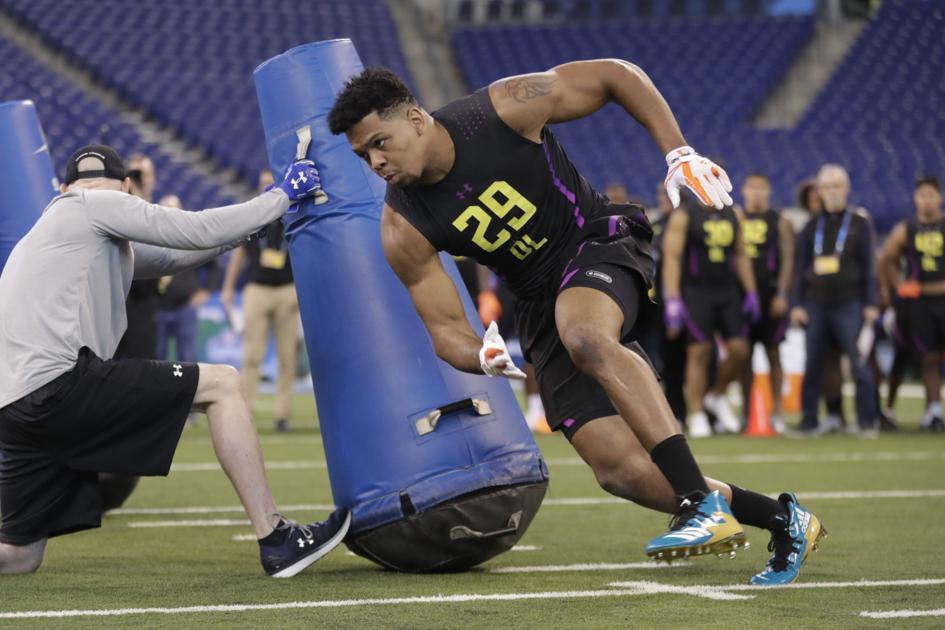The Saints took a risk in trading up to draft Marcus Davenport.
This fact is already known. There is no need to rehash the stakes. And even though snap judgments already exist about the deal, and it will be prematurely graded again after the season, it is probably going to take a few years before accurate evaluations exist.
That doesn’t mean we’re done discussing it. Not even close. One of the more interesting aspects of the trade came to light when ESPN's Mike Triplett pointed out that a deal like this has never happened before. It was the third time in the last 15 years that a team packaged two first-round picks to select a non-quarterback (the other two were receivers), and the first time a team dealt two first rounders to acquire a pick outside of the top 12 (New Orleans moved up from 27 to 14 in exchange for next year's first-round pick and a fifth rounder).
That doesn’t mean any deal for a non-quarterback that isn't Julio Jones is misguided. The Saints would have been better off making the same deal to move up from 27 to 14 in 2007 to get cornerback Darrelle Revis, which would have cost them Robert Meachem and whoever they would have picked in 2008 instead of trading up for Sedrick Ellis (assuming they still got guard Carl Nicks in the fifth). And no one would be questioning a team for making a similar trade to select J.J. Watt in 2011.
It’s easy to pick cherries when they’re already on the ground, and that is what is happening here by pointing toward two generational talents as worthy trade targets. The theory behind the point still stands. Just because something has never happened before doesn’t make the pioneers fools. Talking heads don’t get to make those determinations. Only time does.
But let’s look at this another way. What’s riskier for the Saints: Trading a future first-round pick or going another season – or multiple seasons – without finding a pressure player to serve alongside Cam Jordan? It's not an easy answer, and both arguments have merit.
Can't see video below? Click here.
This stat won’t shock anyone, but the Saints were below the league average in turning pressure into sacks. Among pass rushers with 200 or more pass rushes, the league generated 4,636 pressures and 795 ½ sacks last season, according to Sports Info Solutions. That’s an average of 5.8 pressures per sack.
New Orleans players who had 200 or more rushes generated 144 pressures, which comes right in at the league average. Those guys picked up a sack for every 5.9 pressures. The Saints were a blitz-heavy team, with players bringing pressure from all over the field last season. When counting all defensive players, the team turned every 5.5 pressures into sacks.
Now take Jordan out of the equation and leave in everyone else who rushed 200 or more times. The average number of pressures turned into sacks climbs to 9.18. And that’s with a good secondary. This defense needs help. Maybe time will prove losing the pick was a riskier move. But it’s not hard to make a case for doing whatever it took to find another defensive end.
Another argument that exists is that this was a win-now move. In some respects, it was. Davenport should help the team right away, but this wasn’t the same as the Saints thinking they were on the cusp and then signing Jairus Byrd, as some have argued. You can find good and serviceable safeties a lot of places. The Saints would have liked to sign one of those players at defensive end. They don’t exist. New Orleans has been looking for years, and no one materialized.
Are the Saints expecting this player helps them win now? Of course, but it shouldn’t and won’t be placed on Davenport alone. He’s a piece of the puzzle who in time could develop into a focal point.
Davenport shouldn’t be judged on raw sack totals or even pressures after his first season. It can take time for players at this position – especially guys who are still developing like him – to start cashing in on their full potential. Now, if he comes out like Joey Bosa did for the Chargers and finishes with 10 ½ sacks as a rookie, then proclamations can be made. But it should be avoided if he finishes with four sacks like Vic Beasley did as a rookie for the Falcons, or even with one like Jordan in 2011.
The better measure will be to see how he develops on a weekly basis. Improvement will be what matters here. The numbers will come for Davenport if that’s happening. But if he finishes the year with five sacks and 33 pressures over 401 snaps like Derek Barnett did for the Eagles last season, that would be a success. But closing out with three sacks on 17 pressures like Dallas’ Taco Charlton might not be bad either depending on how the process looks.
There is a certain level of expectation given the investment, but every aspect of this situation needs the time and space to develop before we write conclusions. It is the first time something like this has happened, after all.

